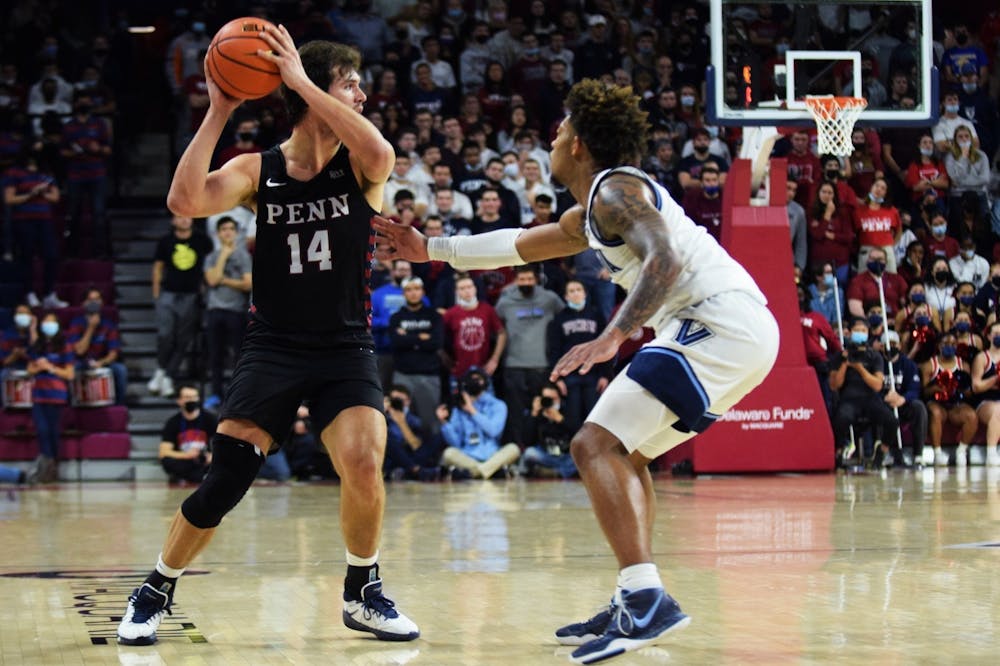"I just love their team. I love watching film of them. You watch certain teams preparing to play them, and you get caught up watching all the good things they do, the intelligent way they play. That's why they're always a tough matchup for us. We couldn't put them away, they hit tough shots in this place."
Those were the words of two-time NCAA Champion and Hall of Fame Villanova coach Jay Wright after his team’s 71-56 win in the Palestra against Penn on Wednesday night. For a team that won by 15, this might sound like Wright just being overly complimentary for politeness’ sake, but with Penn playing without two of its most valuable big men - junior Max Lorca-Lloyd and freshman Nick Spinoso - and having to do so against the No. 6-ranked team in the country, a 15-point loss isn’t exactly unimpressive.
Villanova came into the game an 18.5-point favorite, and although at times it seemed like the Wildcats would hit that benchmark, they never did, as their biggest lead throughout the game totaled 16 points. The Quakers also managed to keep the margin within single-digits through various stretches in the second half and even during part of the last five minutes of the game, an impressive feat against a team likely to go deep in March.
The positive takeaways came primarily through three players alone - sophomore Jordan Dingle, junior Jonah Charles, and sophomore Max Martz (more on that in a bit). For example, 27 minutes into the game, they were the only Quakers to have landed in the points column of the stat sheet, and they combined for exactly three-fourth’s of the team’s total scoring output when it was all said and done. Dingle, in particular, had 21 on his own, guarded the Wildcats’ best player, graduate student Collin Gillespie, for much of the game, and played 37 out of 40 minutes, all after coming into the game questionable to play due to illness.
Although those individual performances were immensely valuable in staying competitive against an elite team like Villanova, they’re indicative of an issue that will need addressing if the team wants to turn around their 3-7 record as they continue Big 5 play and enter Ivy League competition. That is, outside of Dingle, Charles, and Martz, the team struggled to get any offensive production out of its other players.
As mentioned earlier, it took senior Michael Wang (who may be in need of a bump to the starting lineup over junior Michael Moshkovitz) hitting a jumper assisted by senior Jelani Williams with 13:19 left to break up the three-player scoring output. Not even 40 seconds later, sophomore Clark Slajchert continued the diversification, hitting a Lucas Monroe-assisted three-pointer to cut Villanova’s lead to 11.
The value in this differentiation is that it opens up the offense in a way that makes the Red and Blue a tougher force to stop. As obvious as it may seem, it’s key to realize that when more players are capable of scoring, the opportunities for an offensive attack open in a way that benefits spacing, makes the defense not hyper-focus on anybody, and leads to more scoring lanes for star players like Dingle. As such, after five straight points finally came from someone not named Dingle, Charles, or Martz, Dingle was able to knock down a Slajchert-assisted jumper to bring Penn to within single-digits.
To be fair, this problem was exacerbated in the Villanova game more so than it has been in the past, as players such as Williams and an emerging Slajchert have had some big scoring performances so far this season. But in order for the team to be successful, those performances will need to be more consistent game-to-game to allow the offense to become more three-dimensional.
Additionally, while scoring diversification in regard to which players contribute is crucial to the Quakers’ offensive growth, scoring diversification in regard to where the team scores is also a necessary evolution. During Wednesday night’s game against Villanova, Penn scored 39 of its 56 points on three-pointers, two-thirds of the team’s field goal attempts came on three-pointers, and Dingle shot 14 threes alone. Comparatively, the Wildcats were able to dominate inside, besting the Red and Blue in points in the paint by a whopping 32-10 margin.
Granted, having two of the team’s only centers out significantly contributed to both Penn’s inability to stop many of Villanova’s paint attacks and its ineffectiveness to contribute some of their own. But with Spinoso likely out for the rest of the semester, and Lorca-Lloyd projected to be out for even longer, the team will have to find a way to muscle up inside if they want to have any sense of consistency going into the crucial stretches of the regular season.
All in all, Penn played a fairly strong game against Villanova. There were certainly some rough spots - 5-11 from the free-throw line (Kansas nostalgia, anyone?) - but there were enough encouraging factors to think that this team might have a shot - if and when they are fully healthy - at being a competitive unit in the Ivy League.

MATTHEW FRANK is a College sophomore from Miami studying communications and is a Deputy Sports Editor for The Daily Pennsylvanian. He can be reached at dpsports@thedp.com.









